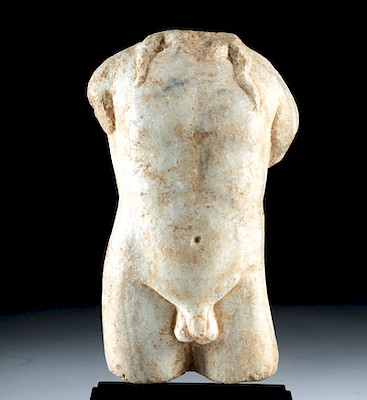Etruscan Terracotta Votive Uterus
Lot 28f
About Seller
Artemis Gallery
686 S Taylor Ave, Ste 106
Louisville, CO 80027
United States
Selling antiquities, ancient and ethnographic art online since 1993, Artemis Gallery specializes in Classical Antiquities (Egyptian, Greek, Roman, Near Eastern), Asian, Pre-Columbian, African / Tribal / Oceanographic art. Our extensive inventory includes pottery, stone, metal, wood, glass and textil...Read more
Estimate:
$400 - $600
Absentee vs Live bid
Two ways to bid:
- Leave a max absentee bid and the platform will bid on your behalf up to your maximum bid during the live auction.
- Bid live during the auction and your bids will be submitted real-time to the auctioneer.
Bid Increments
| Price | Bid Increment |
|---|---|
| $0 | $25 |
| $300 | $50 |
| $1,000 | $100 |
| $2,000 | $250 |
| $5,000 | $500 |
| $10,000 | $1,000 |
| $20,000 | $2,500 |
| $50,000 | $5,000 |
| $100,000 | $10,000 |
| $200,000 | $20,000 |
About Auction
By Artemis Gallery
Dec 5, 2018
Set Reminder
2018-12-05 10:00:00
2018-12-05 10:00:00
America/New_York
Bidsquare
Bidsquare : DAY 1 | Classical Antiquities & Asian Art
https://www.bidsquare.com/auctions/artemis-gallery/day-1-classical-antiquities-asian-art-3698
Day 1 of an important 2-day auction featuring ancient and ethnographic art from around the world. Egyptian, Greek, Roman, Viking, Near Eastern plus Asian Art from China, Japan, Thailand, Vietnam, Burma, India, more. Artemis Gallery info@artemisgallery.com
Day 1 of an important 2-day auction featuring ancient and ethnographic art from around the world. Egyptian, Greek, Roman, Viking, Near Eastern plus Asian Art from China, Japan, Thailand, Vietnam, Burma, India, more. Artemis Gallery info@artemisgallery.com
- Lot Description
Classical World, Northern Italy, Etruria, Hellenistic Period, ca. late 4th to 1st century BCE. An intriguing hollow-molded terracotta anatomical model depicting a uterus, its ovoid body comprised of several raised segments, a projecting lateral element, and a pierced opening surrounded by concentric rings, all covered in vibrant orange slip. Votive uteri like this example were created as offerings to the gods in request of good health or perhaps a successful pregnancy. The unusual form of such uteri was due to only a basic comprehension of human anatomy as those in antiquity rarely practiced exploratory dissection. Scholars posit that, based on the variety of uteri forms, they may represent other internal organs such as the appendix, bladder, or pancreas. Size: 5.5" W x 3.55" H (14 cm x 9 cm).
For a stylistically-similar example of an Etruscan votive uterus, please see The British Museum, museum number 1982,0401.3: http://www.britishmuseum.org/research/collection_online/collection_object_details.aspx?objectId=673097&partId=1
For another stylistically-similar example, please see the Arthur M. Sackler Museum at Harvard University, object number 1977.216.2926: https://www.harvardartmuseums.org/art/290139
Provenance: private East Coast, USA collection
All items legal to buy/sell under U.S. Statute covering cultural patrimony Code 2600, CHAPTER 14, and are guaranteed to be as described or your money back.
A Certificate of Authenticity will accompany all winning bids.
We ship worldwide and handle all shipping in-house for your convenience.
#140230Minor nicks to base, peripheries, and top, with several stable hairline fissures, and a few excisions, otherwise intact and very good. Light earthen deposits throughout. Old inventory number beneath base.Condition
- Shipping Info
-
All shipping is handled in-house for your convenience. Your invoice from Artemis Gallery will include shipping calculation instructions. If in doubt, please inquire BEFORE bidding for estimated shipping costs for individual items.
-
- Buyer's Premium



 EUR
EUR CAD
CAD AUD
AUD GBP
GBP MXN
MXN HKD
HKD CNY
CNY MYR
MYR SEK
SEK SGD
SGD CHF
CHF THB
THB
















